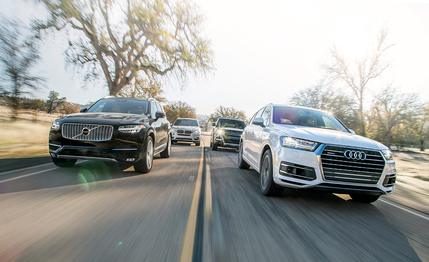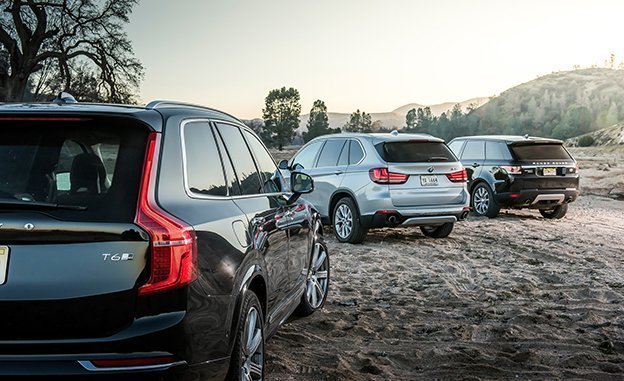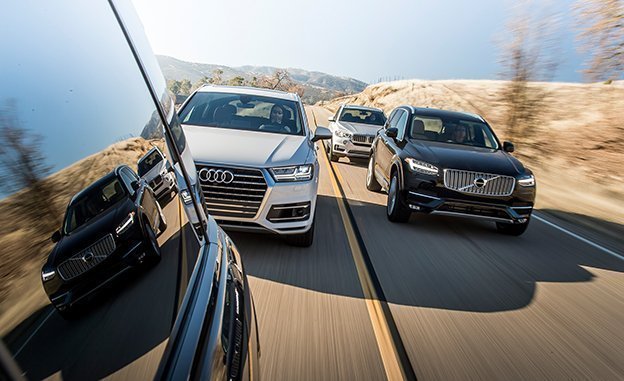
 Comparison Tests
From the March 2016 issue
Comparison Tests
From the March 2016 issue
The ramifications of the crossover—or, more accurately, the unibody SUV—are still vibrating through the luxury segment. Americans just can’t get enough of these pricey family haulers, and buyers are even beginning to choose them over like-sized sedans. To wit: Audi expects the new Q7 to outsell the A6 in a year or two, and the BMW X5 already trumps the 5-series. After only nine months on the market, the redesigned Volvo XC90 is the Swedish brand’s bestseller. And more Americans take home a Land Rover Range Rover Sport than Jaguar sells cars, a big factor in Jag’s decision to build the forthcoming F-Pace SUV.
Practicality is a major reason these crossovers are eating away at mid-size sedan sales. So, in the interest of practicality, we decided to compare the most practical three-row versions, settling on a somewhat impractical price point of $70,000, give or take a few grand. Entering those parameters into the C/D comparotron spit out the four SUVs here. To keep the playing field reasonably level, we equipped each vehicle with a third row of course (optional on the BMW and Rover), power everything, a huge sunroof, active cruise control, blind-spot monitoring, and other safety equipment that allows these crossovers to trundle down the highway with brief moments of autonomy.


Of the four we’ve gathered, the BMW X5 is the undisputed sales champ. BMW averages 45,000 South Carolina–built X5 sales per year in the U.S. Present at the creation of the segment, BMW launched the X5 for 2000 and delivered the third-gen model for the 2014 model year. Add up the options and the 300-hp X5 xDrive35i that starts at a reasonable $57,195 swells into the $68,270 machine tested here.
Audi didn’t sell an SUV until 2006, but the Q7 made up for its tardiness with a big dose of goodness. In the intervening years, updates kept the Q7 fresh and sales strong. The new Q7 is so new that it skips model-year 2016 entirely to jump right to 2017.
The Audi’s price starts at $55,750, but bringing its equipment level in line with the rest of the group means ponying up $9500 for the Prestige trim level. With a few more options—such as the Driver Assistance package, adaptive air suspension, and Glacier White paint—the price rises to $72,875.


The Volvo XC90 is another freshly redesigned luxury crossover. Built on a new platform, the XC90 has the only four-cylinder engine in the class—but a four that is a 316-hp 2.0-liter powerhouse with both a supercharger and a turbocharger strapped to it. It does an amazing impersonation of a larger engine, but the “small heart in a big three-row SUV” strategy reminds us of the ticker in a Great Dane. Those big dogs don’t live long, and the Volvo’s 2.0-liter had us wondering how durable its hardworking heart will prove to be.
The XC90 T6 AWD has a base price of $50,795, but the Inscription trim level’s LED headlights, walnut inlays, vented seats, and decadently soft leathers add $5600. Include the safety and luxury goods that bring parity with the rest of the group and the price goes up to $67,055, still the least expensive of the test.


On the other end of the price scale is the Land Rover Range Rover Sport HSE, a chunk of aluminum that starts at $65,945 but runs to $87,281 when equipped as the others. We could chip away at a few options, such as the Meridian Premium Audio system ($1850), the towing package ($650), black-lacquer wood ($350), rubber mats ($537), and wheel locks ($134), but even without all that, the Range Rover Sport is still more than $80,000. We considered the less dear LR4, but concluded that its body-on-frame architecture—what Land Rover calls integrated body frame—would make it an outlier in the group.
Also considered, but cut for its lack of a third row, was the Mercedes-Benz GLE (formerly the M-class). To get a third row in a Benz SUV requires the larger and more expensive GLS, or the SUV formerly known as the GL-class. We didn’t include the GLS out of concern that its size and price were excessive for this test. This was admittedly before we found out the Range Rover Sport’s as-tested price. Other three-row lux SUVs, such as the Acura MDX, Infiniti QX60, Lexus GX460, and Lincoln MKT, were all deemed too inexpensive, hence this fab four.